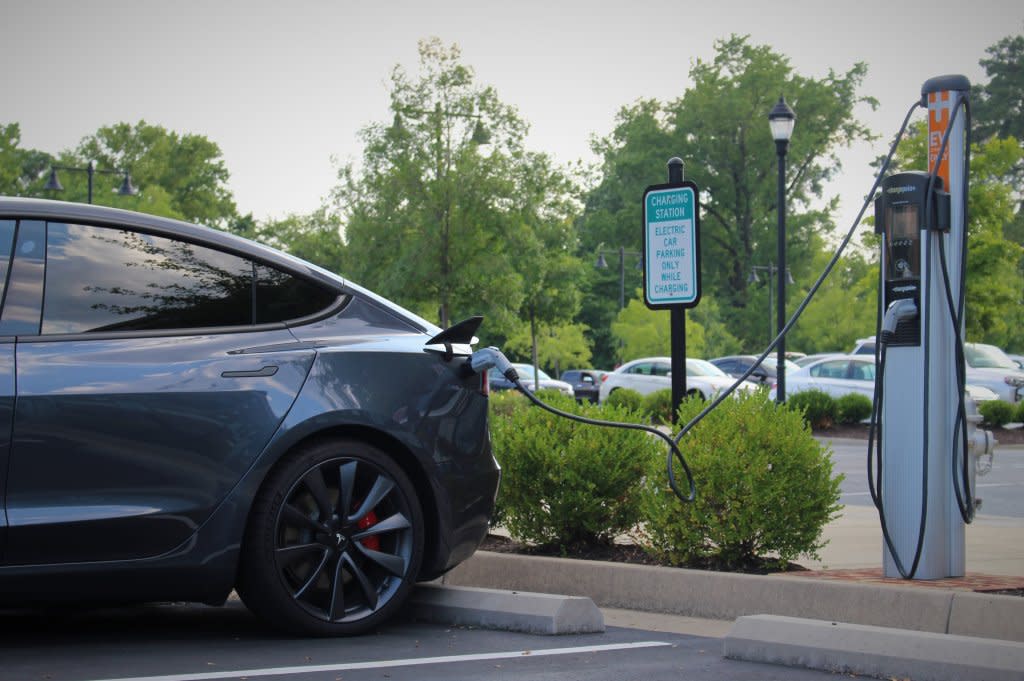Environmental lawyers share how Chevron doctrine’s overturning impacts Virginia

An electric vehicle charges at a public station in Henrico County, July 2020. (Sarah Vogelsong/Virginia Mercury)
The U.S. Supreme Court’s recent decision to overturn the Chevron doctrine could impact environmental protections in Virginia — or not.
While the exact implications are unclear, attorneys with environmental organizations say the overturning could influence Virginia’s tailpipe emissions, but rules around keeping waterways clean appear to be on firmer ground.
“There’s no question you’re going to see more industry group challenges,” said Trip Pollard, a senior attorney with the Southern Environmental Law Center.
The doctrine
The Chevron doctrine stems from a ruling that’s been in place for decades and gives deference to agencies to interpret laws as they see fit when writing regulations.
But Last month, SCOTUS overturned that ruling by saying when a law doesn’t clearly delineate authority, it’s up to the courts to decide how to interpret its meaning.
“Of course, when faced with a statutory ambiguity in such a case, the ambiguity is not a delegation to anybody, and a court is not somehow relieved of its obligation to independently interpret the statute,” Chief Justice John Roberts wrote in the majority opinion.
Tailpipe emissions
On the environmental front, the U.S. Environmental Protection Agency’s federal tailpipe emissions standards, expected to apply to Virginia next year, are one example of how protections could change.
Virginia was set to follow California’s tailpipe regulations after Democrats passed a law in 2021 tying the state to those standards, which are stricter than the federal rules. But in June, Republican Gov. Glenn Youngkin and Attorney General Jason Miyares announced that Virginia will revert back to the federal regulations.
Both the federal and California rules aim to cut down on tailpipe emissions by transitioning drivers to use electric vehicles, but environmental groups have said California’s faster pace of transition was needed to combate change. Republicans have pushed back against the transition because of the cost and lack of charging infrastructure concerns.
The federal rules could be scaled back even more though with a pending lawsuit against them, and Pollard said that the removal of the Chevron doctrine impact is “immediate.”
In an interview with Reuters, David Pettit, senior attorney for climate and energy with the Natural Resources Defense Council, said challengers will argue the EPA, “did not have the legal ability to decide that the Clean Air Act covers [greenhouse gas] emissions from mobile sources, because it doesn’t say that in the Clean Air Act.”
Water protections
The federal legislation on protecting waterways is the Clean Water Act, which gives Virginia the authority to administer regulations alongside its own laws.
It’s unclear how the authority delegated to Virginia under the CWA may be impacted without the Chevron doctrine, said Patrick Fanning, Virginia staff attorney with the Chesapeake Bay Foundation.
But one way the CWA applies to Virginia is through enforcement of total daily maximum loads (TMDLS) or plans to clean up polluted waterways. The TMDLS are seen as crucial components toward cleaning up rivers and streams that feed into the plagued Chesapeake Bay.
The Clean Water Act clearly states that once a waterway is listed as impaired, the EPA is able to impose clean up requirements, Fanning added.
“Of course there’s less specificity in the Clean Water Act than in the TMDL regulations, but the authority to do that is clear in the Clean Water Act,” Fanning said.
Further, Virginia has its own State Water Control law, which is intended to be consistent with the federal laws, but doesn’t appear to be in jeopardy.
Two previous cases in Virginia, Manassas Autocars, Inc., v. Couch and Commonwealth v. American Radiator & Standard Sanitary Corp. in. 1960, give deference to DEQ to impose regulations from that law through the rulemaking process, Fanning added.
“The Supreme Court of Virginia basically said construction of statutes by public officials, the state agencies that are charged with administering them, is entitled to deference from the court,” Fanning said, while referencing the 1960 case.
Future changes
As a result of the removal of the Chevron doctrine, Pollard and Fanning say future federal laws will likely have specific stipulations, which may pose a challenge given Congress’ difficulty to pass a bill in general. Also, including specific regulations for toxic emissions limits may be hard if the level of toxic emissions is unknown
“When congress passes something they don’t and can’t spell out every detail,” Pollard said. “That’s why we have these agencies with expertise in particular subject matter. They have their process for public input.”
The number of legal challenges to regulations could also skyrocket, because a six-year statute of limitations was also changed with the loss of the Chevron doctrine. Previously, new rules could only be challenged within six years of their adoption. But now, a new business entity may be able to challenge a regulation that was crafted more than six years prior.
“I think it creates a lot of uncertainty about things that had otherwise been well settled,” said Fanning.
GET THE MORNING HEADLINES DELIVERED TO YOUR INBOX
The post Environmental lawyers share how Chevron doctrine’s overturning impacts Virginia appeared first on Virginia Mercury.

